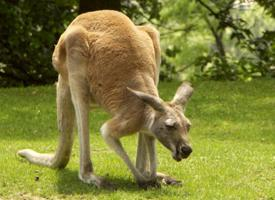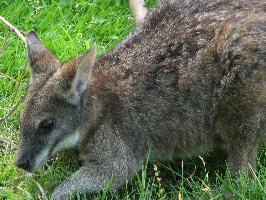
Weights and measures
| Length | 120 cm |
|---|---|
| Weight | 65 kg |
Biological data
| Length of gestation | 36 d |
|---|
Animal description
The Eastern grey kangaroo (Macropus giganteus) is a captivating marsupial native to the eastern regions of Australia. Renowned for its distinctive grey coat and impressive size, this species is one of the most emblematic and widely recognized animals in Australia. Adult Eastern grey kangaroos can reach a head and body length of up to 2 meters (6.6 feet), with males typically larger and more muscular than females. These kangaroos possess powerful hind legs designed for leaping, a long, muscular tail for balance, and a small head with large ears that swivel independently to detect sounds.The Eastern grey kangaroo's coat color ranges from light grey to brownish-grey, providing excellent camouflage in their natural habitat. This coloration allows them to blend seamlessly into the forest and grassland environments where they reside. The underparts are generally lighter, offering a stark contrast to the darker, more uniform colors of their back and sides.
These kangaroos are primarily crepuscular and nocturnal, meaning they are most active during the twilight hours and at night. During the day, they often rest in the shade of trees or in tall grass to avoid the heat. Their diet consists mainly of grasses and small leafy plants. They are known for their ability to survive in areas with scarce water sources, obtaining most of their hydration from their food.
Socially, Eastern grey kangaroos are quite gregarious. They live in groups known as mobs, which can consist of up to 100 individuals, although smaller groups of around 10 are more common. These mobs provide protection against predators and facilitate social interactions. Within these groups, there is a complex social structure, with dominant males often having priority access to females for mating.
Reproduction in Eastern grey kangaroos involves a fascinating process known as embryonic diapause, in which the development of the embryo can be paused during adverse conditions. Females are capable of giving birth to one joey at a time, which, after birth, crawls into its mother's pouch to continue its development. Joeys typically remain in the pouch for about nine months before starting to explore the outside world, but they may continue to nurse for up to 18 months.
The Eastern grey kangaroo plays a significant role in the ecosystem, acting as a key species in controlling vegetation growth and providing prey for large predators. Despite facing threats from habitat loss and collisions with vehicles, the Eastern grey kangaroo remains abundant in its range. It is also an iconic symbol of Australian wildlife, featuring prominently in Australian culture and national identity.
Similar Animals
New photos of animals
Top 10 animals
- Dolphin gull (Leucophaeus scoresbii)
- Diana monkey (Cercopithecus diana)
- Moustached guenon (Cercopithecus cephus)
- Galápagos tortoise (Geochelone nigra complex)
- Japanese macaque (Macaca fuscata)
- Stone loach (Barbatula barbatula)
- Russian tortoise (Testudo horsfieldii)
- Greek tortoise (Testudo graeca)
- Common flying dragon (Draco volans)
- Vendace (Coregonus albula)


